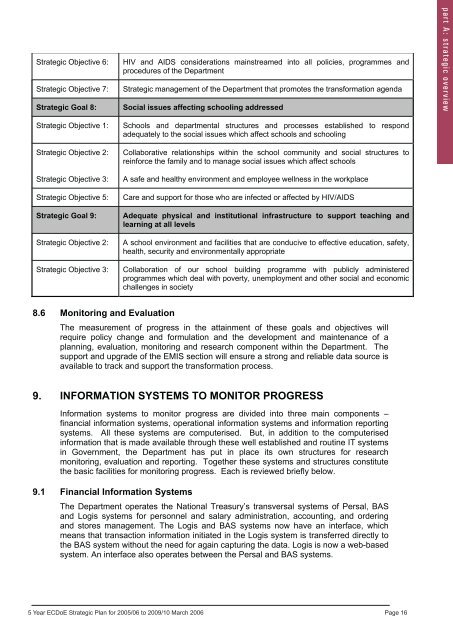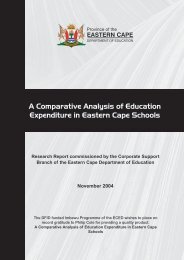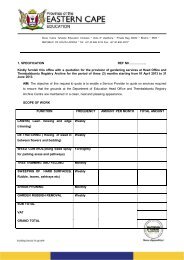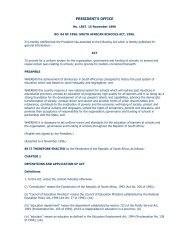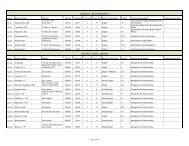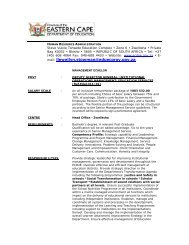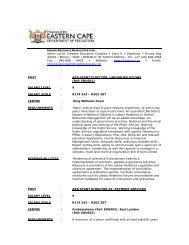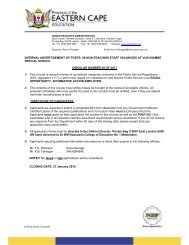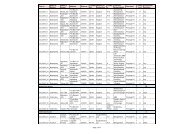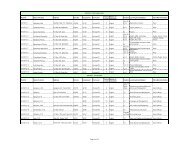part a: strategic overview - Department of Education
part a: strategic overview - Department of Education
part a: strategic overview - Department of Education
You also want an ePaper? Increase the reach of your titles
YUMPU automatically turns print PDFs into web optimized ePapers that Google loves.
Strategic Objective 6: HIV and AIDS considerations mainstreamed into all policies, programmes and<br />
procedures <strong>of</strong> the De<strong>part</strong>ment<br />
Strategic Objective 7: Strategic management <strong>of</strong> the De<strong>part</strong>ment that promotes the transformation agenda<br />
Strategic Goal 8: Social issues affecting schooling addressed<br />
Strategic Objective 1: Schools and de<strong>part</strong>mental structures and processes established to respond<br />
adequately to the social issues which affect schools and schooling<br />
Strategic Objective 2: Collaborative relationships within the school community and social structures to<br />
reinforce the family and to manage social issues which affect schools<br />
Strategic Objective 3: A safe and healthy environment and employee wellness in the workplace<br />
Strategic Objective 5: Care and support for those who are infected or affected by HIV/AIDS<br />
Strategic Goal 9: Adequate physical and institutional infrastructure to support teaching and<br />
learning at all levels<br />
Strategic Objective 2: A school environment and facilities that are conducive to effective education, safety,<br />
health, security and environmentally appropriate<br />
Strategic Objective 3: Collaboration <strong>of</strong> our school building programme with publicly administered<br />
programmes which deal with poverty, unemployment and other social and economic<br />
challenges in society<br />
8.6 Monitoring and Evaluation<br />
The measurement <strong>of</strong> progress in the attainment <strong>of</strong> these goals and objectives will<br />
require policy change and formulation and the development and maintenance <strong>of</strong> a<br />
planning, evaluation, monitoring and research component within the De<strong>part</strong>ment. The<br />
support and upgrade <strong>of</strong> the EMIS section will ensure a strong and reliable data source is<br />
available to track and support the transformation process.<br />
9. INFORMATION SYSTEMS TO MONITOR PROGRESS<br />
Information systems to monitor progress are divided into three main components –<br />
financial information systems, operational information systems and information reporting<br />
systems. All these systems are computerised. But, in addition to the computerised<br />
information that is made available through these well established and routine IT systems<br />
in Government, the De<strong>part</strong>ment has put in place its own structures for research<br />
monitoring, evaluation and reporting. Together these systems and structures constitute<br />
the basic facilities for monitoring progress. Each is reviewed briefly below.<br />
9.1 Financial Information Systems<br />
The De<strong>part</strong>ment operates the National Treasury’s transversal systems <strong>of</strong> Persal, BAS<br />
and Logis systems for personnel and salary administration, accounting, and ordering<br />
and stores management. The Logis and BAS systems now have an interface, which<br />
means that transaction information initiated in the Logis system is transferred directly to<br />
the BAS system without the need for again capturing the data. Logis is now a web-based<br />
system. An interface also operates between the Persal and BAS systems.<br />
5 5 Year ECDoE Strategic Plan Plan for for 2005/06 2005-06 to to 2009/10 2009-10. March 21 F 2006 (6).doc Page 16 Page 16<br />
contents <strong>part</strong> A: <strong>strategic</strong> <strong>overview</strong>


